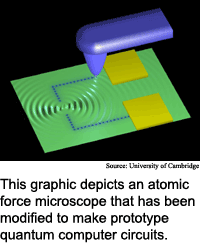
Tool sketches quantum circuits
Computer chips are manufactured using photo
lithography -- a technique that employs light and chemicals to etch microscopic
features into silicon.
Researchers routinely use electron beam lithography, which uses
beams of electrons instead of photons, to etch even smaller devices, like
the quantum dots that trap single electrons to form the building blocks
of quantum computers.
Electron beam lithography is a very slow process, however.
Researchers from Cambridge University in England and the Massachusetts
Institute of Technology have developed a lithographic technique, dubbed
erasable electrostatic lithography, that allows a quantum device to be drawn
in a few hours rather than a couple of weeks.
The researchers modified a scanning tunneling microscope so that
they could sketch charge patterns onto the surface of a piece of the semiconductor
gallium arsenide and erase the patterns using red light. The surface charge,
which draws from a subsurface sheet of electrons, defines working quantum
components.
The researchers have used the method to define quantum wires, dots
and hills, and are currently working on improving the technique's resolution,
according to the researchers.
The method could be used practically in five years, according to
the researchers. The work appeared in the August 14, 2003 issue of Nature.
Software speeds modeling
DNA plays tic-tac-toe
Email updates six degrees theory
Cellophane turns LCDs 3D
News briefs:
Detector senses single DNA
Crystal shortens infrared waves
Tool sketches quantum circuits
Nanotubes spark gas detector
Metal process makes heat chips
Light makes molecule shine

Research Watch blog
View from the High Ground Q&A
How It Works
RSS Feeds:
News
Ad links:
Buy an ad link
Ad links: Clear History
Buy an ad link
|
TRN
Newswire and Headline Feeds for Web sites
|
© Copyright Technology Research News, LLC 2000-2010. All rights reserved.